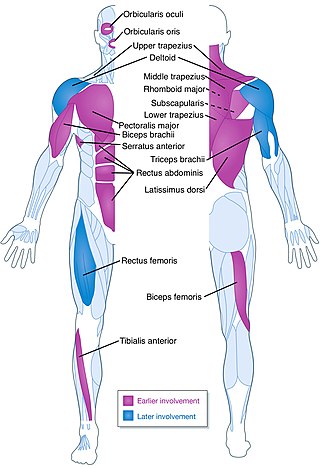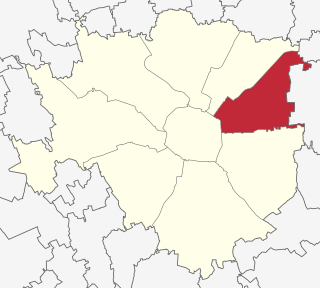Related Research Articles

Pathology is the study of disease and injury. The word pathology also refers to the study of disease in general, incorporating a wide range of biology research fields and medical practices. However, when used in the context of modern medical treatment, the term is often used in a narrower fashion to refer to processes and tests that fall within the contemporary medical field of "general pathology", an area that includes a number of distinct but inter-related medical specialties that diagnose disease, mostly through analysis of tissue and human cell samples. Idiomatically, "a pathology" may also refer to the predicted or actual progression of particular diseases, and the affix pathy is sometimes used to indicate a state of disease in cases of both physical ailment and psychological conditions. A physician practicing pathology is called a pathologist.
The National Institute of Arthritis and Musculoskeletal and Skin Diseases (NIAMS) is one of the institutes and centers that make up the National Institutes of Health, an agency of the United States Department of Health and Human Services (HHS).

Duchenne muscular dystrophy (DMD) is a severe type of muscular dystrophy that primarily affects boys. Muscle weakness usually begins around the age of four, and worsens quickly. Muscle loss typically occurs first in the thighs and pelvis followed by the arms. This can result in trouble standing up. Most are unable to walk by the age of 12. Affected muscles may look larger due to increased fat content. Scoliosis is also common. Some may have intellectual disability. Females with a single copy of the defective gene may show mild symptoms.
Nemaline myopathy is a congenital, often hereditary neuromuscular disorder with many symptoms that can occur such as muscle weakness, hypoventilation, swallowing dysfunction, and impaired speech ability. The severity of these symptoms varies and can change throughout one's life to some extent. The prevalence is estimated at 1 in 50,000 live births. It is the most common non-dystrophic myopathy.

Casa Sollievo della Sofferenza is a private scientific research hospital in San Giovanni Rotondo, Italy, founded by Saint Pio of Pietrelcina, and administered by Vatican City. Inaugurated on 5 May 1956, the hospital has adopted modern technologies and is often considered as one of the most efficient scientific research hospitals in Europe. The building is situated at the highest part of the town, on the top of the hill, giving the location an identity of a hospital-town. Casa Sollievo della Sofferenza has two major activity wings. One of which is an internationally regarded hospital for the relief of suffering and the other is a state-of-the-art scientific research centre which had received the status of a Scientific Hospitalization and Treatment Institute (IRCCS), an institute of national interest, by the decree of Italian Ministry of Health in 1991. The research centre is also home to the Genomic and Genetic Disorders Biobank which is part of the Telethon Network of Genetic Biobanks and conducts basic and pre-clinical research and clinical trials in collaboration with pharmaceutical companies. It is first in the world to run non-profit clinical trials. The hospital has established Institute for Stem-cell Biology, Regenerative Medicine and Innovative Therapies (ISBReMIT) that will be the first factory of GMP neural stem cells in Europe for producing bio-drugs and cell-drugs. ISBReMIT has a dedicated area for the start-ups and spin-offs in biotechnology. Casa Sollievo della Sofferenza also houses a large out-patient clinic, a hospital-school for the children suffering from cancer and other genetic disorders, a reception centre which is a hotel complex, and a social-assistance residence for elderly. Casa Sollievo della Sofferenza also owns two agricultural companies-Masseria Calderoso and Posta La Via. It also hosts one spiritual centre, prayer group and a church. In front of Casa Sollievo della Sofferenza there is Sanctuary of Saint Pio of Pietrelcina, named after the founder of this hospital and research centre. In 2023, it was featured on the list of World's Best Smart Hospitals 2023.
DNA banking is the secure, long term storage of an individual’s genetic material. DNA is most commonly extracted from blood, but can also be obtained from saliva and other tissues. DNA banks allow for conservation of genetic material and comparative analysis of an individual's genetic information. Analyzing an individual's DNA can allow scientists to predict genetic disorders, as used in preventive genetics or gene therapy, and prove that person's identity, as used in the criminal justice system. There are multiple methods for testing and analyzing genetic information including restriction fragment length polymorphism (RFLP) and polymerase chain reactions (PCR).

Facioscapulohumeral muscular dystrophy (FSHD) is a type of muscular dystrophy, a group of heritable diseases that cause degeneration of muscle and progressive weakness. Per the name, FSHD tends to sequentially weaken the muscles of the face, those that position the scapula, and those overlying the humerus bone of the upper arm. These areas can be spared, and muscles of other areas usually are affected, especially those of the chest, spine, abdomen, and shin. Almost any skeletal muscle can be affected in severe disease. Abnormally positioned, or winged, scapulas are common, as is the inability to lift the foot, known as foot drop. The two sides of the body are often affected unequally. Weakness typically manifests at ages 15 – 30 years. FSHD can also cause hearing loss and blood vessel abnormalities in the back of the eye.
Kearns–Sayre syndrome (KSS), oculocraniosomatic disorder or oculocranionsomatic neuromuscular disorder with ragged red fibers is a mitochondrial myopathy with a typical onset before 20 years of age. KSS is a more severe syndromic variant of chronic progressive external ophthalmoplegia, a syndrome that is characterized by isolated involvement of the muscles controlling movement of the eyelid and eye. This results in ptosis and ophthalmoplegia respectively. KSS involves a combination of the already described CPEO as well as pigmentary retinopathy in both eyes and cardiac conduction abnormalities. Other symptoms may include cerebellar ataxia, proximal muscle weakness, deafness, diabetes mellitus, growth hormone deficiency, hypoparathyroidism, and other endocrinopathies. In both of these diseases, muscle involvement may begin unilaterally but always develops into a bilateral deficit, and the course is progressive. This discussion is limited specifically to the more severe and systemically involved variant.

A neuromuscular disease is any disease affecting the peripheral nervous system (PNS), the neuromuscular junctions, or skeletal muscles, all of which are components of the motor unit. Damage to any of these structures can cause muscle atrophy and weakness. Issues with sensation can also occur.

Spinal muscular atrophy (SMA) is a rare neuromuscular disorder that results in the loss of motor neurons and progressive muscle wasting. It is usually diagnosed in infancy or early childhood and if left untreated it is the most common genetic cause of infant death. It may also appear later in life and then have a milder course of the disease. The common feature is progressive weakness of voluntary muscles, with arm, leg and respiratory muscles being affected first. Associated problems may include poor head control, difficulties swallowing, scoliosis, and joint contractures.

A biobank is a type of biorepository that stores biological samples for use in research. Biobanks have become an important resource in medical research, supporting many types of contemporary research like genomics and personalized medicine.
A biorepository is a facility that collects, catalogs, and stores samples of biological material for laboratory research. Biorepositories collect and manage specimens from animals, plants, and other living organisms. Biorepositories store many different types of specimens, including samples of blood, urine, tissue, cells, DNA, RNA, and proteins. If the samples are from people, they may be stored with medical information along with written consent to use the samples in laboratory studies.
Danon disease is a metabolic disorder. Danon disease is an X-linked lysosomal and glycogen storage disorder associated with hypertrophic cardiomyopathy, skeletal muscle weakness, and intellectual disability. It is inherited in an X-linked dominant pattern.
Décrypthon is a project which uses grid computing resources to contribute to medical research. The word is a portmanteau of the French word "décrypter" and "telethon".

The Carlo Besta Neurological Institute is a hospital and research institute in Milan. Is known to be one of the most important neurological hospitals in the world.
The Coriell Institute for Medical Research is an independent, non-profit biomedical research center dedicated to the study of the human genome. Coriell features programs in biobanking, personalized medicine, cell biology, cytogenetics, genotyping, and induced pluripotent stem cell science. Located in downtown Camden, New Jersey, the Institute has partnered with several prominent state and national health leaders, including Cooper University Hospital, the Cooper Medical School of Rowan University, the United States Air Force, the University of Pennsylvania, and Stanford University.
Michael G Hanna is Director of the UCL Institute of Neurology, University College London and professor in clinical neurology and consultant neurologist at the National Hospital for Neurology and Neurosurgery, Queen Square, London, and also Director of the Medical Research Council (MRC) Centre for Neuromuscular Disease.

Giuseppe Merla is an Italian scientist who is a Full Professor of Molecular Biology at University of Naples Federico II and medical geneticist at Casa Sollievo della Sofferenza in San Giovanni Rotondo, Italy. He is the Managing Director of Fondazione Telethon-Genomic and Genetics Disorders Biobank, a member of EuroBioBank at the Casa Sollievo della Sofferenza Hospital. Merla and his team led the discovery of a new rare genetic syndrome intellectual development disorder with cardiac arrhythmia and the gene responsible for it. Merla is also known for his extensive research on Kabuki Syndrome. He has been declared as the Ambassador of Kabuki syndrome and received the 2019 Ambassador Day award at the Royal Villa of Monza.
Professor Patrick Francis Chinnery, FRCP, FRCPath, FMedSci, is a neurologist, clinician scientist, and Wellcome Trust Principal Research Fellow based in the Medical Research Council Mitochondrial Biology Unit and the University of Cambridge, where he is also Professor of Neurology and Head of the Department of Clinical Neurosciences.

AmadeoLab is an Italian research institute based in Milan, Italy. The lab is a public hospital, currently representing the headquarters of the IRCCS National Cancer Institute (INT). and of the Neurological Institute "Carlo Besta". The building is made up of seven floors which contain all the medical, administrative and research departments. The Institute performs tests to prevent and diagnose potential oncological illnesses, and provides appropriate medical care and assistance for their treatment.
References
- ↑ "EU funded network provides human biological material for research on rare diseases". Times Higher Education . 5 October 2005. Retrieved 26 November 2011.
- ↑ "EuroBioBank® - About EuroBioBank". Archived from the original on 2012-04-26. Retrieved 2011-11-26.